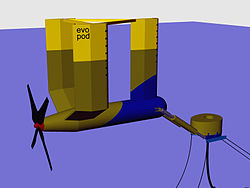Tidal stream power

Tidal stream power is the hydropower of the tidal movement of water. A tidal stream generator is a machine that extracts energy from moving water in tides. Tidal stream generators draw energy from water currents in much the same way as wind turbines draw energy from air currents.
Tidal stream power is the cheapest and the least ecologically damaging among the three main forms of tidal power generation.[1]
Tidal stream power is a relatively new technology. It was first conceived in the 1970s during the oil crisis.[2]
The potential for power generation by an individual tidal turbine can be greater than that of similarly rated wind energy turbine. Water is about 800 times the density of air. So, water pushing against a turbine can provide much more power than air pushing against a similar turbine at the same speed. Also, the lowest water speeds needed for an economic power project is lower than the wind speed needed for a wind turbine project.[3] In practice, the tide must move at speeds of at least 2 knots (1 m/s) even close to neap tides to be a source of power.
As with wind power, selection of location is critical for the tidal turbine. Tidal stream systems need to be located in areas with fast currents where natural flows are concentrated between obstructions, for example at the entrances to bays and rivers, around rocky points, headlands, or between islands or other land masses.
Environmental impact
The main concern has been whether the turbines kill fish. Very little direct environmental research or observation of tidal stream systems exists. Most direct observations consist of releasing tagged fish upstream of the device(s) and direct observation of mortality or impact on the fish.
One study of the Roosevelt Island Tidal Energy (RITE, Verdant Power) project in the East River (New York City), had 24 split beam hydroacoustic sensors (scientific echosounder) to detect and track the movement of fish both upstream and downstream of each of six turbines. The results suggested (1) very few fish using this portion of the river, (2) those fish which did use this area were not using the portion of the river which would subject them to blade strikes, and (3) no evidence of fish traveling through blade areas.[4]
Work is currently being conducted by the Northwest National Marine Renewable Energy Center (NNMREC)[5] to explore and establish tools and protocols for assessment of physical and biological conditions and monitor environmental changes associated with tidal energy development.
References
- ↑ "Tidal power". Archived from the original on 23 September 2010. Retrieved 1 November 2010.
- ↑ Jones, Anthony T., and Adam Westwood. "Power from the oceans: wind energy industries are growing, and as we look for alternative power sources, the growth potential is through the roof. Two industry watchers take a look at generating energy from wind and wave action and the potential to alter." The Futurist 39.1 (2005): 37(5). GALE Expanded Academic ASAP. Web. 8 October 2009.
- ↑ "Surfing Energy's New Wave" Time International 16 June 2003: 52+. http://www.time.com/time/magazine/article/0,9171,457348,00.html Archived 2012-01-30 at the Wayback Machine
- ↑ "Roosevelt Island Tidal Energy (RITE) Environmental Assessment" (PDF). Retrieved October 31, 2011.[dead link]
- ↑
Tidal Stream Power Media
Two types of Tidal Stream Generators Evopod - A semi-submerged floating approach tested in Strangford Lough with SeaGen in the background.
"Northwest National Marine Renewable Energy Center". Retrieved October 31, 2011.





